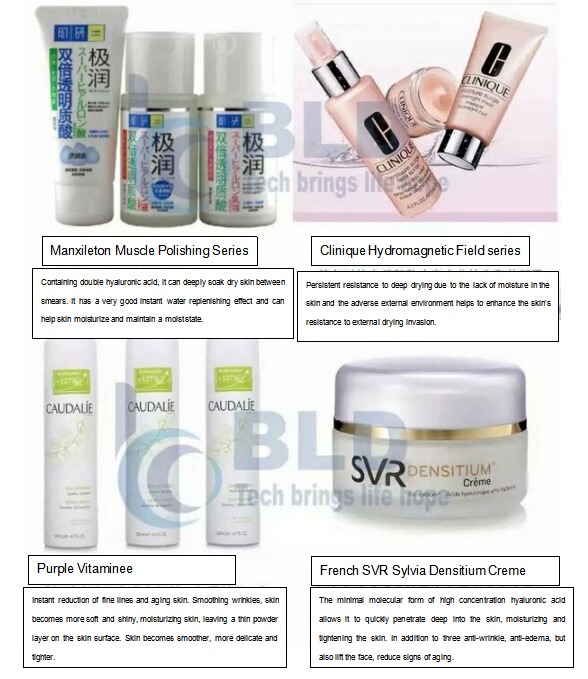Product Itroduction

Oligohyaluronic Acid
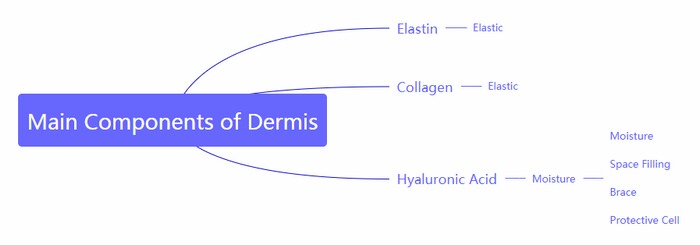
1. Aging affects the content of hyaluronic acid in the skin
Hyaluronic acid content:
Infancy:
puberty:
Adulthood:
Gerontic:
Rapid decline after 18
Less than half after age 10
Accelerate skin aging
Skin's ability to retain moisture decreases with wrinkles
Generation and elastic decline
2. The role and importance of hyaluronic acid in skin
2.1. Keep moderate moisture content (deep skin moisturizing)
-Ceramide: skin surface Moisturizing
-Hyaluronic acid: deep moisturizing of skin
2.2 support elastin collagen;
2.3 provide cell nutrition and strengthen tissue lubrication.
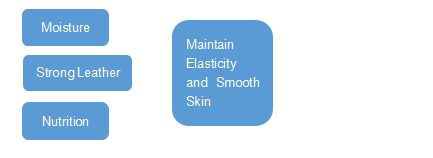
Product characteristics of hyaluronic acid
1. Hyaluronic acid is a natural biological substance, which is extracted from animal tissue or fermented by microorganisms, and is not synthesized chemically.
2. Hyaluronic acid is an inherent moisturizing factor in the skin. Skin care products containing HA can increase HA in the epidermis and play a moisturizing role together with the inherent HA in the skin.
3. Unique hygroscopicity. In low humidity environment, its hygroscopicity is higher than other moisturizers, while in high humidity environment, its hygroscopicity is lower than other moisturizers. Unique intelligent moisture absorption is suitable for the skin in different seasons, different environmental humidity requirements for cosmetics moisturizing effect. Hyaluronic acid in general cosmetics has a large molecular weight and is not easily absorbed by the skin. Its moisturizing effect is to form a barrier on the skin surface. A better way for the skin is to select small molecular weight HA - 3000 oligomeric hyaluronic acid.
Efficiency and Characteristics of Products
1. Absorbing water: Help skin absorb a lot of water, can absorb about 1000 times its own weight of water, so that epidermal cells re-filling, smoothing wrinkles.
2. Repair and moisturize: It can instantly deeply moisturize, increase skin elasticity and tension, help restore normal oil and water balance, improve dry and relaxed skin, and have the function of repairing epidermal tissue.
3. Anti-aging:
(1) Skin permeability and cell permeability are strong; (2) Promoting cell proliferation; (3) Inhibiting the expression of elastase and promoting the expression of collagen I to achieve anti-aging in vitro; (4) Activating stem cells to resist wrinkles; (5) Anti-aging in vivo.
Efficacy test of oligohyaluronic acid
artificial skin & human fibroblasts & human keratinocytes
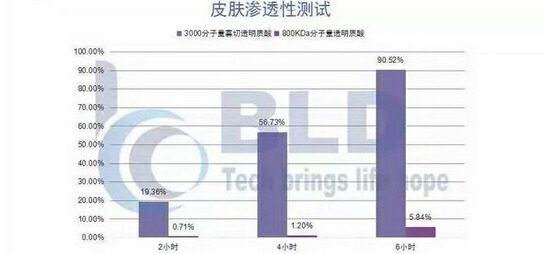
3000 molecular weight oligo cutting hyaluronic acid
8000kda molecular weight hyaluronic acid
Results: The skin permeability of 3000 molecular weight oligohyaluronic acid increased with time. After 6 hours, the skin permeability of 3000 molecular weight oligohyaluronic acid was 90.52%, almost 100%. The permeability of 800KDa sodium hyaluronate was only 5.84%, 84.68% lower than 3000 molecular weight oligohyaluronic acid. It can be seen that 3000 molecular weight oligohyaluronic acid has strong skin penetration and can achieve deep moisturization of skin.
Results:
The skin permeability of 3000 molecular weight oligohyaluronic acid increased with time. After 6 hours, the skin permeability of 3000 molecular weight oligohyaluronic acid was 90.52%, almost 100%. The permeability of 800KDa sodium hyaluronate was only 5.84%, 84.68% lower than 3000 molecular weight oligohyaluronic acid. It can be seen that 3000 molecular weight oligohyaluronic acid has strong skin penetration and can achieve deep moisturization of skin
Test Method:
(1) Human colon cancer cells were inoculated on 24-well Transwell plate (diameter 12 mm, pore size 0.4 mm). The cell density of each pore was 1 x 105 cells/ml, the culture medium was MEM, 10% calf serum, 1% NEAA solution, 100 ug/ml penicillin streptomycin and 7.5% sodium bicarbonate. The cells were cultured in 5% CO2, 37 C incubator and changed every day. Nine days later, TEER was used to detect cell confluence (TEER value > 300_ cm2 under complete cell confluence, to calibrate the cell confluence as a blank value for transfection test).
(2) After receiving and discarding the original medium, the samples were added into the HBSS-HEPES medium (HBSS contains 10 mM HPEPS buffer solution, adjusting the pH value of the medium with 5 mol/L sodium hydroxide to 7.4), 2.5 mg/ml small molecule hyaluronic acid (3000Da) and hyaluronic acid (1000KDa). The samples were treated for 2, 4 and 6 hours, then the samples were absorbed from the upper and lower layers of each pore and preserved at 4 degree.
(3) The contents of hyaluronic acid and hyaluronic acid in medium were determined by GPC, and the permeability was obtained by comparing the contents of samples in medium, upper and lower of each pore.
Transwell plate: laboratory consumables for cell migration experiments
NEAA solution: nonessential amino acid
TEER: Transmembrane Resistance Value
HBSS: Inorganic Salt Solution and Equilibrium Salt Solution
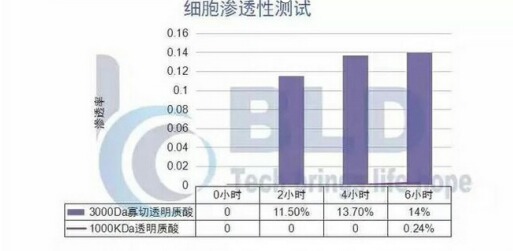
Results: The cell permeability of 3000Da oligohyaluronic acid increased significantly with time, and it was 14% after 6 hours.
The cell permeability of 1000KDa sodium hyaluronate was not obvious, 0.24% at 6 hours, which was lower than 3000Da oligomeric hyaluronic acid.
13.76%. It can be seen that 3000Da oligohyaluronic acid not only has very strong skin permeability, but also penetrates deep cells.
4.1. Stimulate the expression of HAS-2 (hyaluronic acid synthase) in fibroblasts. Small molecule oligomeric hyaluronic acid infiltration
After penetration into the dermis, the hyaluronic acid content in the skin is increased by stimulating the expression of hyaluronic acid synthase.
4.1. Stimulate the expression of HAS-2 (hyaluronic acid synthase) in fibroblasts. Small molecule oligomeric hyaluronic acid infiltration
After penetration into the dermis, the hyaluronic acid content in the skin is increased by stimulating the expression of hyaluronic acid synthase.
4.2. Inhibiting the expression of elastase. Small molecule oligohyaluronic acid can inhibit the expression of elastase, reduce the enzymatic hydrolysis of elastin, keep skin elastic and reduce wrinkles.
4.3. Promote the expression of type I collagen. Small molecule oligohyaluronic acid can increase collagen content and enrich skin by promoting the expression of type I collagen.
Test: IGFBP-2, 3000Da oligochiral hyaluronic acid (0.0002%)

+
IGFBP-2: Insulin-like binding protein is the main factor in DSCs. It plays an important role in skin epidermal renewal and maintaining the stem-like function of human epidermal keratinocytes.
Integrin: A protein that adheres to the basement membrane of the basal cell nucleus, regulates dermal and epidermal junctions, mediates signal transduction from the extracellular matrix to the cell, and is associated with cell growth, division, survival and differentiation. It is composed of alpha and beta subunits
Test: IGFBP-2, 3000Da oligochiral hyaluronic acid (0.0002%)
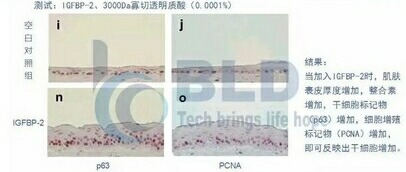
When IGFBP-2 was added, skin epidermis thickness, integrin and stem cell markers increased.
(p63) increase, cell proliferation markers (PCNA) increase, can reflect the increase of stem cells.
P63: One of the markers of stem cells, which plays an important role in skin regeneration and skin composition, proliferation and maintenance of stem cells, is highly expressed in basal cells of human epithelial tissue and plays an important role in the differentiation of ectoderm during embryonic development. Closing p53-induced apoptosis is beneficial to vitamin D.
The basal cell proliferative capacity is maintained.
PCNA: Value-added cell nuclear antigen, expressed in DNA synthesis phase.
Test: IGFBP-2, 3000Da oligochiral hyaluronic acid (0.0002%)
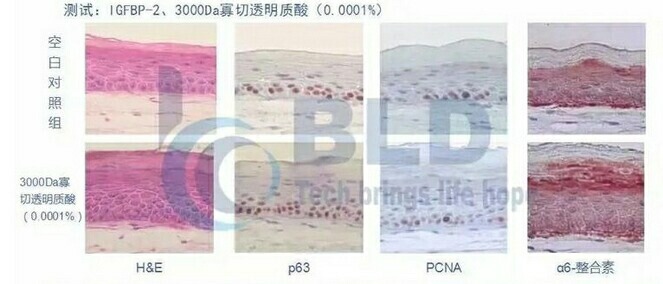
aH&E: Hematoxylin-eosin staining method, hematoxylin staining solution is alkaline, mainly makes the chromatin in nucleus and ribosome in cytoplasm violet-blue; eosin is acid dye, mainly makes the components in cytoplasm and extracellular matrix red basophilic structure usually includes the parts containing nucleic acid, such as ribose.
Ribonucleic acid (RNA) rich regions in body, nucleus and cytoplasm, etc. Eosinophilic structures are usually consists of proteins within and between cells, such as Lewy body, alcohol body and most of cytoplasm.
Test: IGFBP-2, 3000Da oligochiral hyaluronic acid (0.0002%)
Results: Integrin increased, stem cell markers (p63), cell proliferation markers (PCNA), envelope protein and silk polymerase protein increased. Integrin increased, stem cell markers (p63), cell proliferation markers (PCNA), envelope protein and silk polymerase protein increased.
Summary: Oligotopic hyaluronic acid increases the number of p63 positive cells and the regulation of integrin α 6 and β 1
It can increase the thickness of epidermis and promote the differentiation of epidermis.
Involucrin: Envelope protein, which exists in the medulla at the end of differentiation and is the main component of keratinized envelope. Side chains are rich in glycine and asparagus.
Amino acid, a marker for differentiation of skin, is expressed early in the late stage of differentiation of keratinocytes.
Filaggrin: Silk polymeric protein, rich in histidine, serves as a matrix for protein binding and plays an important role in maintaining the skin moisture content.
|
Test Method In Vivo Anti-aging Test of Oligohyaluronic Acid |
|
|
Test Mechanism |
Ellead Skin Research Center, Korea |
|
Test Material |
3000 DaltonOligochromic hyaluronic acid (0.2%) |
|
Research duration |
8 weeks |
|
Research volunteers |
22female(30-55 years old, average age 45.4 years) All the volunteers were randomly divided into two groups: I and II. The volunteers used the left and right corners of the eyes separately. |
|
Research Process |
Cream containing 3000 Dalton oligohyaluronic acid (0.2%) and blank cream twice a day. |
|
Evaluation of wrinkle resistance in vivo |
In order to evaluate the wrinkle-resistant effect, dermatology evaluates the improvement of wrinkles in corners of eyes visually. Fixed face with fixing device, wrinkle camera set and high definition digital camera and camera system lighting, then take photos. Image description and analysis were performed by PRIMOS (Fast Phase Shift of Skin in Vivo Measurement, GFMesstechnik GmbH, Germany). |
|
Skin elasticity test |
The eyeface elasticity was measured by skin elastometer SEM575. The instrument was equipped with a 2 mm probe and adjusted to mode 1 or time-strain mode. Under mode 1, the negative pressure was 450 mbar. Open every 2 seconds for measurement. Open time lasts 2 seconds for 3 consecutive times. |
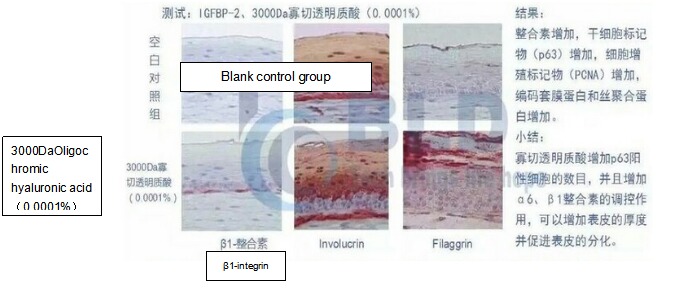
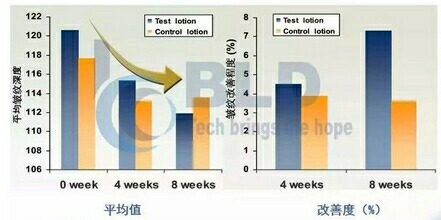
6.1. Evaluation of wrinkle resistance in vivo
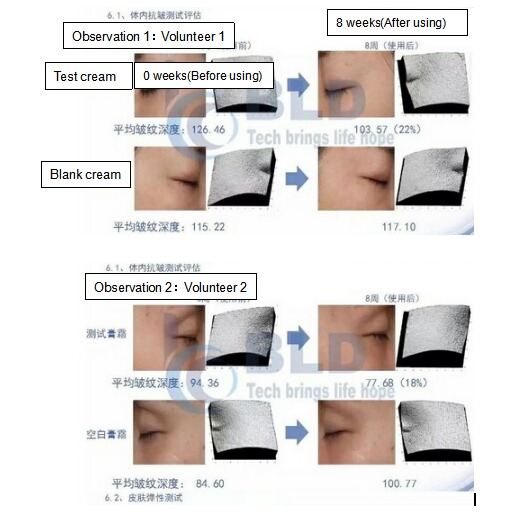

|
Product Name |
Oligohyaluronic Acid |
|
INCI Name |
Sodium Hyaluronate |
|
Content |
>99.5% |
|
Molecular Weight |
Oligopoly (3000-10000 MW) |
|
Efficacy |
Deep moisturizing, activating cells, anti wrinkle and anti-aging |
|
Feature |
White to light yellow powder |
|
Solubility |
Completely water soluble |
|
Application |
Facial products: skin care, make-up, spray, facial mask, facial cleanser, body care, shower gel, hair care products, etc. |
|
Formula Guidelines |
In the production of emulsified cosmetics, HA solution, as part or all of the water phase, is like a flower with oil phase. In the production of non emulsified cosmetics, it can be evenly stirred with other ingredients. When added to the formula at 80 ℃, the activity of oligo - cut hyaluronic acid will not be affected. |
|
PH Applicable |
4.5-7.0 |
|
Recommended Usage |
0.05-0.5% |
